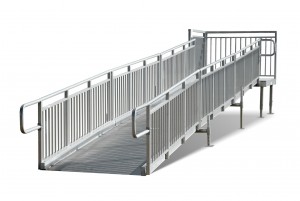If you are looking for wheelchair ramps for schools in Santa Ana, California, reach out to REDD Team. Our school accessibility experts will help ensure that your property meets ADA (Americans with Disabilities Act), IBC (International Building Code), and DSA (Division of the State Architect) of California requirements to keep students of all abilities safe.

REDD Team is a product brand of Hydro Extrusion North America, part of the world’s largest aluminum extrusion company. We manufacture high-quality aluminum access products, such as aluminum stairs (OSHA and general code), universal stair systems, ADA wheelchair ramps, aluminum pedestrian bridges, aluminum walkways, and more.
Comparing Aluminum Alloys
What sets our access systems apart is our focus on the aluminum alloys we use in their construction.
Our Universal Wheelchair Ramp System is typically constructed from 6000 series aluminum alloy with 6061-T6 for structural strength. Handrails and guardrails are fabricated with aluminum construction alloy 6061-T6, 6063-T5 or 6063-T6.
6061 Alloy
This alloy is an outstanding substitute for mild steel products. It is tough, structurally strong, easy to weld and join, will keep its shape in spite of extreme cold or heat, and is highly resistant to rust and corrosion from environmental conditions. 6061 alloy is one of the least expensive and most versatile aluminum alloys and can be formed into almost any imaginable shape.
6063 Alloy
6063 is one of the most popular alloys in the 6000 series. It has good extrudability and a high-quality surface finish, which makes it useful for a wide variety of applications from electrical components to architectural and building products. In its 6063-T6 heat treated condition, it is very resistant to corrosion and stress cracking. In its 6063-T5 condition, it offers slightly lower shear strength and ultimate tensile strength compared to 6063-T6.
Evaluating Wheelchair Ramp Materials
You will find ADA- and DSA-compliant ramps made of concrete, wood, steel or aluminum, and each has its pros and cons.
- Concrete is durable and stable. Its surface can be brushed to incorporate slip-resistant properties. However, concrete is expensive and, once built, is virtually impossible to modify if your needs change.
- Wood is an inexpensive but may rot, splinter, or warp if not protected with sealer or varnish (handrails included) and stored properly. Wood joints may become loose or wobbly. Also, board spacing is very important; they must be placed close enough together to avoid bumps, but far enough apart to allow good water drainage.
- Steel has the same strength-to-weight ratio as aluminum, but is three times heavier than aluminum, making steel wheelchair ramps difficult to transport and handle. Steel also must be galvanized to prevent rust and corrosion, and a texture must be added to the surface to help prevent slipping. It must also be repainted every few years.
- Aluminum is strong, rust-resistant, lightweight, eco-friendly, and will not warp, rot, or splinter. Unlike wood, which will shrink and expand, an aluminum access system will maintain its shape in spite of extreme cold or heat. Since it can be extruded, aluminum can be formed into almost any imaginable shape. These qualities make it ideal for ramps, stairs, platforms, bridges and similar structures.
When you need ADA- or DSA-compliant wheelchair ramps for schools in Santa Ana, California, contact REDD Team at (800) 648-3696 to learn more about our premium American-made Universal Wheelchair Ramp System.

